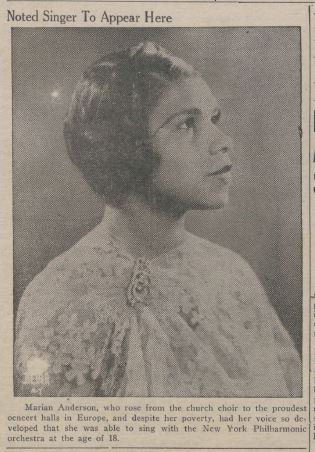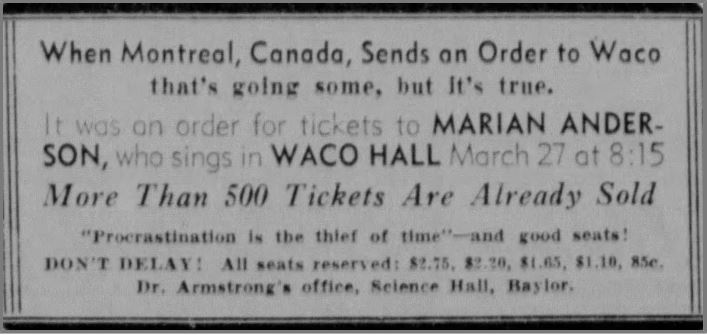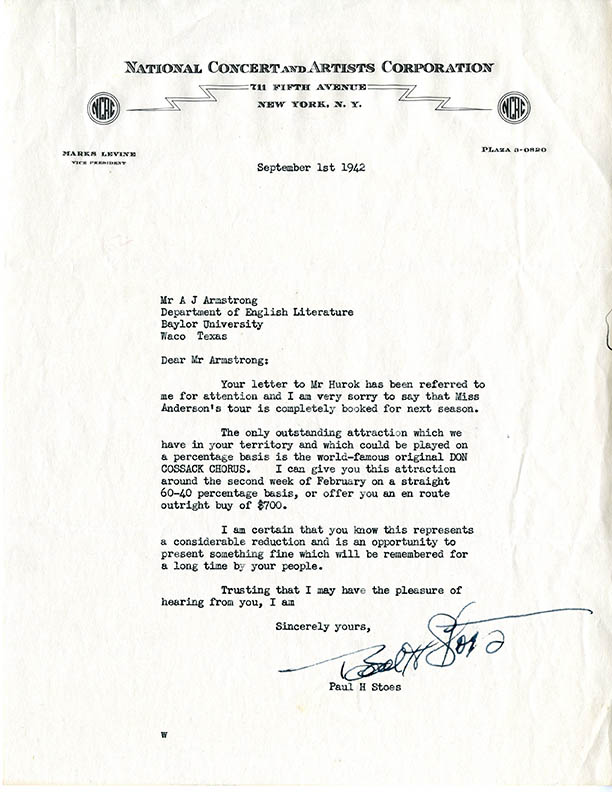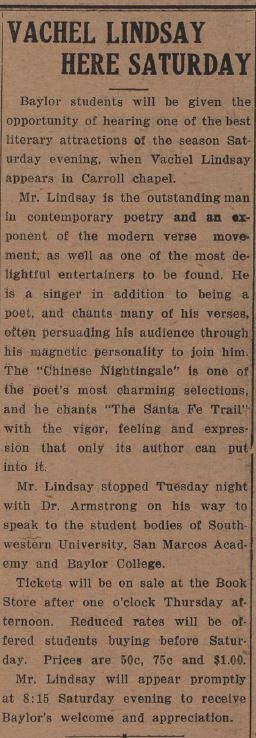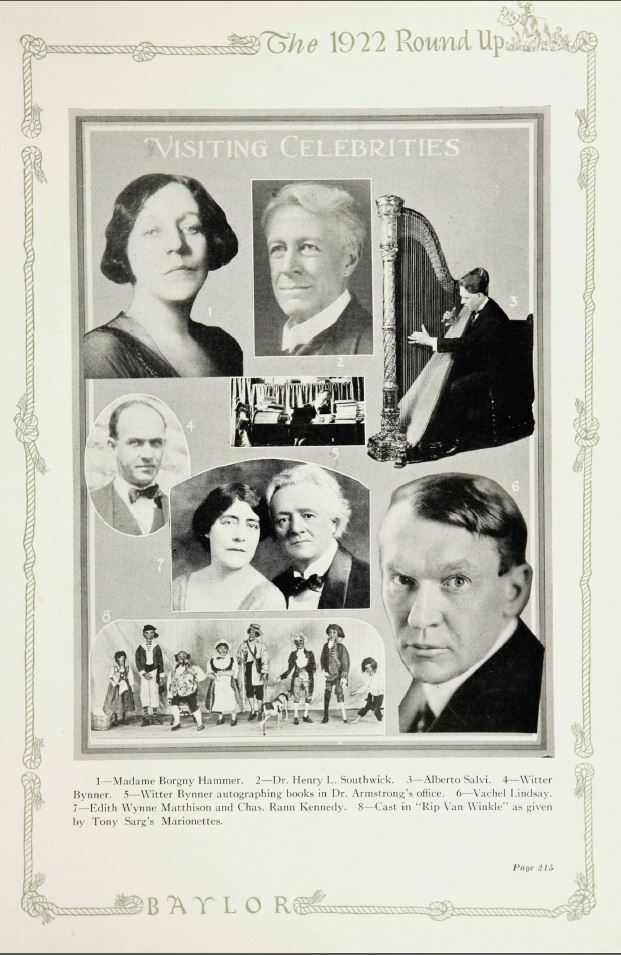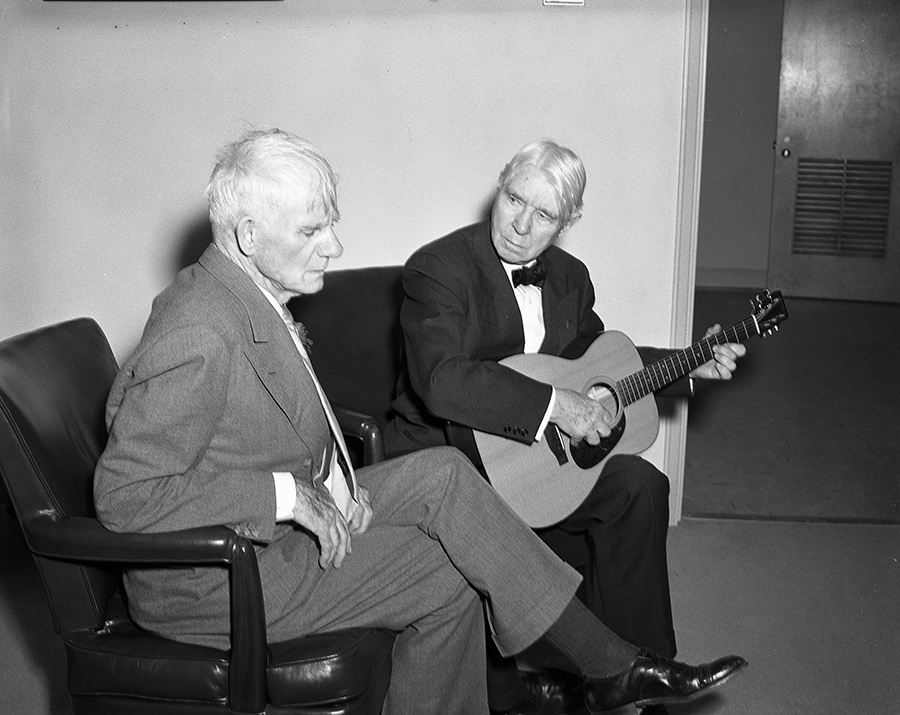“Armstrong’s Stars” is a collaboration between the Armstrong Browning Library and Baylor’s Texas Collection. Once a month we feature a story about a celebrity that Dr. A.J. Armstrong brought to Baylor. These stories highlight an interesting part of Baylor’s history and include collection materials housed in both the Armstrong Browning Library and the Texas Collection.
This month’s story was contributed by Ph.D. candidate Jeremy Land.

When he arrived at Baylor in 1922, Robert Frost was one of the most famous poets in America. He had yet to win many of the accolades that would come later in life, but he was well on his way to becoming the household name that he is today. By the time Dr. A.J. Armstrong asked Robert Frost to come and read at Baylor, the poet was already known for his dramatic monologues and innovative blank verse celebrating the lives of New England farmers. Many of his more famous works like “Mending Wall,” “Birches,” and “The Road Not Taken” were well on their way to becoming staples in the American literary canon and poems to study for many American students.
Because of this popularity Frost earned a series of teaching jobs and public readings around the country. However, his confessed love for “barding around, ” a phrase he used to describe his itinerate lecturer lifestyle, had not really brought him very far south, and it apparently would take some convincing before the poet would come to Baylor in 1922 (Burnshaw). To sell Frost on the merits of reading poetry in Texas, Dr. Armstrong relied on his relationship with other literary luminaries who had previously read here. It even took the efforts of fellow poet and mutual friend Carl Sandburg to write Frost on Dr. Armstrong’s behalf and promise him that “they [Baylor students] not only read a man’s books before he arrives but they buy them in record-breaking numbers” (Sandburg 213).
We may never know whether or not Sandburg’s promise of profits and literate crowds was the tipping point in convincing Frost to come to Texas, but we can say that within a few months of Sandburg’s letter, Frost arrived in Dallas for a five city tour of Texas universities. Throughout November of 1922, Robert Frost gave readings at Southern Methodist University, Mary Hardin-Baylor, the City of Temple, and Southwestern University in Georgetown, in addition to Baylor; all of course were arranged by Baylor’s own Dr. A.J. Armstrong. According to the Baylor Lariat, Frost was said to have enjoyed his time at Baylor so much that he frequently said over the next few years that he would like to return to Waco (“Robert Frost, Famous Poet Speaks Here” 1).

It may have taken him a decade, but in 1933 Dr. Armstrong again convinced the New England poet to return to Texas for a second reading. By that time Frost’s reputation as a poet had only grown exponentially. Just two years earlier, he won his second of four Pulitzer prizes for his collected works and was well on his way to completing his seventh volume of original poetry. When he arrived for the second time, Frost was greeted with close to 500 audience members, all eager to hear him recite his most famous works (“Robert Frost, Famous Poet Speaks Here” 1). Ultimately, Frost’s two visits to Baylor left a lasting mark on the University. When he died in 1963, the Lariat dedicated two full pages to the poet’s life and praised his contribution to the American literary landscape. In the end, Robert Frost’s time at Baylor might be best summed up by the students themselves who claimed in their 1923 yearbook that Robert Frost’s visits “materially help[ed] put Baylor on the map” (The Round Up 161).
Works Cited
Burnshaw, Stanley. “Robert Frost.” American National Biography Online. American National Biography Online, Feb. 2000. Web. 5 June 2015
“Robert Frost, Famous Poet Speaks Here.” The Daily Lariat [Waco] 19 Apr. 1933: 1. Web. 5 June 2015
The Round Up. Ed. Enid Eastland. Vol. 22. Jefferson City: Hugh Stephens, 1923. 161. Web. 5 June 2015
Sandburg, Carl. Letter to Robert Frost. Summer 1922. The Letters of Carl Sandburg. Orlando: HBJ, 1968. 213. Print.
Learn more about Armstrong’s Stars in previous posts.
